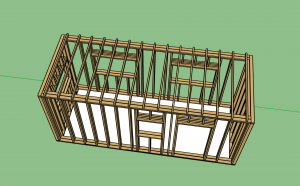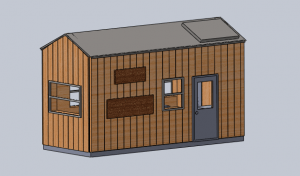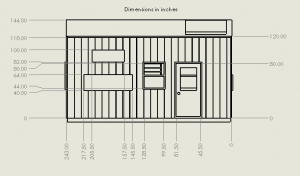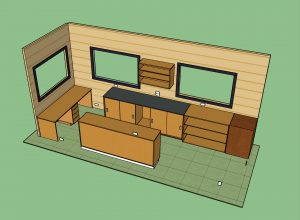The Interior and Exterior design team focused on the design and layout of custom furnishings both inside and outside the Tiny Research Station (TRS). We worked to evaluate and accommodate the needs of the users of the space (ecology researchers and educators) while upholding energy and green building design constraints. Together with the Green Building Team and Energy Modeling team, we created a design that provides plenty of natural light and solar heat gain while incorporating local and sustainable materials.
Design Process
At beginning of the design process, we first collected the needs of our users and gained a sense of where the station will be located and how it will be used. We set up meetings with the researchers at the Second College Grant (SCG) to gather information about their current research space setup and research activities. We found they will primarily conduct research by using microscopes, dissecting samples, and collecting/entering data. Therefore, ample counter and desk space with proper lighting was necessary, as well as multiple outlets throughout the space. Researchers also requested lots of storage space to store their tools and samples, and a gathering space for communal work.
With these specifications defined, we moved on to creating preliminary designs using Solidworks and SketchUp. By using sketches and prototypes we were able to make simple modifications and iterations of designs, while still being able to visual the full space. We shared designs with the researchers and requested feedback before finalizing our designs.
Interior and Exterior Renderings




Files for the interior and exterior models are included below.
Material Selection
With the Green Building team, we selected materials that were Red list-free, locally sourced, and with low embodied carbon. We also considered materials that would complement the natural aesthetic of the Second College Grant (SCG). Three materials we highlight are the exterior cladding, interior siding, and flooring.
Exterior Cladding: Cedar Shingles
Cedar is naturally rot-resistant, pest-repellent, and durable species of wood that requires no chemical finish. Therefore it was a optimal choice for exterior cladding. We chose shingles as opposed to shiplap cedar siding as the former is more cost-effective and lower in embodied carbon.
Interior Siding: Pine Shiplap
We chose locally sourced 12" pine shiplap for the interior as wood is an abundant renewable resource in the area. Importantly, the pine siding will remain undamaged during the frequent trips between the SCG and Hanover, unlike more typical siding materials like sheetrock or plaster. It also mimics the natural environment of the SCG with its unfinished look, and allows for easy installation and disassembly/replacement.
Flooring: Marmoleum Click-lock
Marmoleum Click-lock flooring tiles are a USDA-certified biobased product, made from linseed oil and wood flour. It requires no adhesives, chemicals, or fasteners, allowing for easy installation and disassembly. It is weather-proof and wear-resistant--a necessary characteristic to withstand the heavy boots of ecologists at the SCG. The Pine Forest color will again lean on the outdoor aesthetic and provide a natural refreshing feeling.
Furnishing Designs
Furniture pieces will be designed around ergonomic and green design principles. The desk, lab bench, and cabinets will be sized at appropriate, ergonomic heights for a comfortable workspace. They will include a kick-space (the recessed space along the bottom) which allows for the body to stand closer to the counter without leaning. Cabinets will close with sliding doors to prevent items from falling out when in motion. Shelves will be adjustable to various heights as needed, and secured both on the top and bottom. Open shelving units will include removable panels to be attached during transit. All furniture items are intended to be constructed with pocket hole joints to allow for easy disassembly either for modification or proper sorting at the end of life. They will be designed without the use of modern hardware (e.g. drawer slides) for simplification and to minimize waste.
Preliminary designs of furniture are included in the SketchUp files. Created with the help and feedback of Lee Schutte and Greg Elder.
Files
- Floor Plans
- Interior and Furniture Models
- Exterior
- Framing Plans